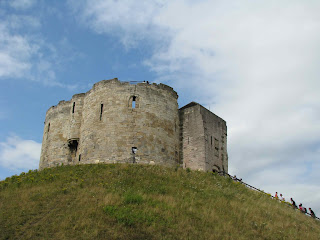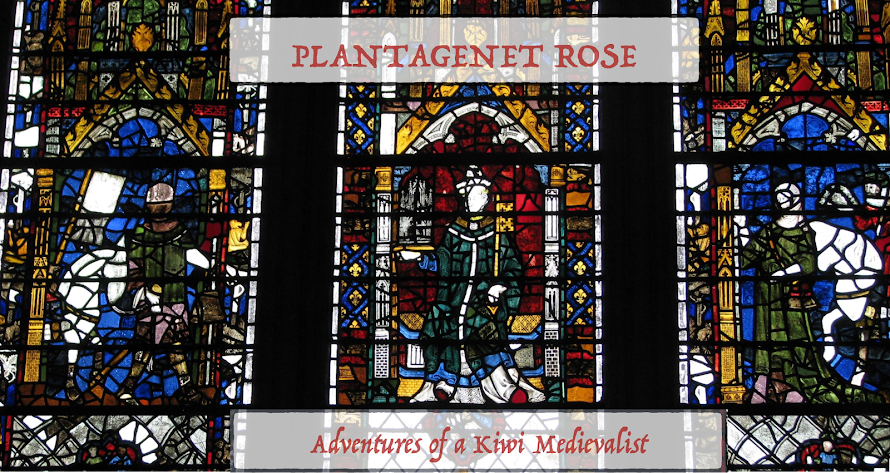Wednesday 29 July 2015
York Minster fact sheets
The Minster has a collection of helpful factsheets, liberally illustrated with lots of lovely photographs, on its website. See https://www.yorkminster.org/learning/school-visits/activities-amp-resources/york-minster-fact-sheets.html
St William of York
 |
| The Great West Window of York Minster (affectionately known as 'The Heart of Yorkshire'). The bottom row of the window depicts eight archbishops of York, one of which is Saint William. |
St William (late 11th century - 1154) is York's patron saint and the city's answer to Canterbury's Thomas a Becket. He was elected Archbishop of York in 1141, though his reign was a rather stormy one. Several miracles were attributed to him (including the miraculous preservation of his body in one of the Minster's fires, which mirrored one of St Thomas' miracles) and quite a cult grew up around his figure, a cult which contributed to York's sense of local identity.
St William was buried in York Minster; his tomb and shrine here became a place of pilgrimage. It is tempting, though perhaps not very edifying, to imagine some competition or rivalry between York and Canterbury. Both were important cities religiously, politically and economically and both seemed to have played up the presence and the merits of their respective local saints. Rivalry between the north and south of England appears to be as old as the hills!
There is some evidence for Whitsuntide plays performed in York in honour of Saint William, which would pre-date the city's much more famous Corpus Christi Mystery cycle.
St William features largely in the stained glass of York Minster; below is a very rare 12th century statue depicting him, now standing in All Saints Church North Street.
For further reading about St William see Ellen K. Rentz, "Castles for St. William: The Late Medieval Commemoration of York's Local Saint," Viator 43, no. 2 (2012), 111 - 129. For a more brief overview of his life, his struggles surrounding his election to the Archbishopric of York, and his stained glass in the Minster, see https://www.yorkminster.org/geisha/assets/files/16%20St%20William.pdf
St William was canonised in 1227 (apparently after some lobbying by the citizens of York). His feast day is 8th June, the day of his death (reportedly by poisoned wine in his chalice).
 |
| 12th century wooden statue thought to depict St William, All Saint's North Street |
Wednesday 15 July 2015
The Pearl of York
St Margaret Clitherow, 'the Pearl of York,' was martyred 25th March 1586 for sheltering Catholic priests in her home. Her feast day is 30th August.
 |
| St Margaret's house in the Shambles |
 |
| The place of her execution, near the bridge over the Ouse, just up from Mickelgate |
 |
| St Margaret in her shrine |
 |
| statue of St Margaret in St Wilfred's church |
Tuesday 14 July 2015
York Minster
 |
| The two west turrets |
 |
| This dragon head is actually a counterweight, and was used to lever the very heavy font lid on and off. |
 |
| Looking up the nave towards the quire |
 |
| Five Sisters window |
 |
| Climbing the tower (275 steep, winding, narrow steps!) |
 |
| Looking across the leads |
 |
| Made it to the top! |
 |
| The two west turrets again |
 |
| The quire screen has statues of the kings who reigned while the Minster was being built (William the Conqueror to Henry VI.) This is Richard II. |
 |
| Roof boss |
 |
| Stained glass windows of the Chapter House |
 |
| Ceiling of the chapter house |
 |
| A sad little fellow who took my fancy |
 |
| Statue of Virgin and Child decapitated during the Reformation |
 |
| The 'catherdra' - Bishop's throne |
 |
| The Pilgrims' Window |
Monday 13 July 2015
Walking through York
 |
| The Shambles |
 |
| In York, a street is a 'gate', and a gate is a 'bar'! |
 |
| Exercise yard of York prison |
 |
| Clifford's Tower, all that remains of a motte-and-bailey castle built by William the Conquerer |
 |
| River Ouse |
 |
| Ruins of St Mary's Abbey, dissolved by Henry VIII |
 |
| YORK MINSTER! (it is so big that it has to be written in capitals!) |
 |
| Pretty houses |
 |
| Mickelgate Bar (where the mystery plays started from) |
Saturday 11 July 2015
Friday 10 July 2015
Subscribe to:
Posts (Atom)


















